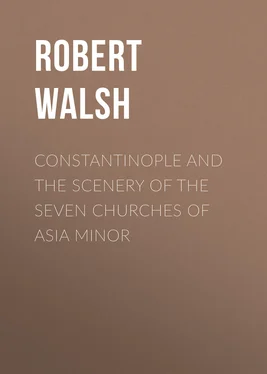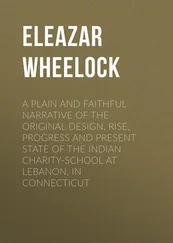Robert Walsh - Constantinople and the Scenery of the Seven Churches of Asia Minor
Здесь есть возможность читать онлайн «Robert Walsh - Constantinople and the Scenery of the Seven Churches of Asia Minor» — ознакомительный отрывок электронной книги совершенно бесплатно, а после прочтения отрывка купить полную версию. В некоторых случаях можно слушать аудио, скачать через торрент в формате fb2 и присутствует краткое содержание. Жанр: foreign_prose, foreign_home, История, foreign_antique, на английском языке. Описание произведения, (предисловие) а так же отзывы посетителей доступны на портале библиотеки ЛибКат.
- Название:Constantinople and the Scenery of the Seven Churches of Asia Minor
- Автор:
- Жанр:
- Год:неизвестен
- ISBN:нет данных
- Рейтинг книги:5 / 5. Голосов: 1
-
Избранное:Добавить в избранное
- Отзывы:
-
Ваша оценка:
- 100
- 1
- 2
- 3
- 4
- 5
Constantinople and the Scenery of the Seven Churches of Asia Minor: краткое содержание, описание и аннотация
Предлагаем к чтению аннотацию, описание, краткое содержание или предисловие (зависит от того, что написал сам автор книги «Constantinople and the Scenery of the Seven Churches of Asia Minor»). Если вы не нашли необходимую информацию о книге — напишите в комментариях, мы постараемся отыскать её.
Constantinople and the Scenery of the Seven Churches of Asia Minor — читать онлайн ознакомительный отрывок
Ниже представлен текст книги, разбитый по страницам. Система сохранения места последней прочитанной страницы, позволяет с удобством читать онлайн бесплатно книгу «Constantinople and the Scenery of the Seven Churches of Asia Minor», без необходимости каждый раз заново искать на чём Вы остановились. Поставьте закладку, и сможете в любой момент перейти на страницу, на которой закончили чтение.
Интервал:
Закладка:
The great materials being thus at hand, artists were wanted to work them up. So much, however, had the arts declined, that none could be found to execute the emperor’s designs, and it was necessary to found schools every where, to instruct scholars for the purpose; and, as the pupils became improved and competent, they were despatched in haste to the new city. But though architects might be thus created for the ordinary civil purposes, it was impossible to renovate the genius of sculpture, or form anew a Phidias or a Praxiteles. Orders therefore were sent to collect whatever specimens could be found of the great artists of antiquity; and, like Napoleon in modern times, he stripped all other cities of their treasures, to adorn his own capital. Historians record the details of particular works of art deposited in this great and gorgeous city, as it rose under the plastic hand of its founder, scarcely a trace of which is to be seen at the present day, and the few that remain will be described more minutely hereafter. Suffice it to say, that the baths of Zeuxippus were adorned with various sculptured marble, and sixty bronze statues of the finest workmanship; that the Hippodrome, or race-course, four hundred paces long, was filled with pillars and obelisks; a public college, a circus, two theatres, eight public and one hundred and fifty private baths, five granaries, eight aqueducts and reservoirs for water, four halls for the meeting of the senate and courts of justice, fourteen temples, fourteen palaces, and four thousand three hundred and eighty-eight domes, resembling palaces, in which resided the nobility of the city, seemed to rise, as if by magic, under the hand of the active and energetic emperor.
But the erection that gives this city perhaps its greatest interest, and it is one of the few that has escaped the hand of time or accident, is that which commemorates his conversion to Christianity. He not only placed the Christian standard on the coins of his new city, but proclaimed that the new city itself was dedicated to Christ. Among his columns was one of red porphyry, resting on a base of marble; between both he deposited what was said to be one of the nails which had fastened our Saviour to the cross, and a part of one of the miraculous loaves with which he had fed the five thousand; and he inscribed on the base an epigram in Greek, importing that he had dedicated the city to Christ, and “placed it under his protection, as the Ruler and Governor of the world.” Whenever he passed the pillar, he descended from his horse, and caused his attendants to do the same; and in such reverence did he hold it, that he ordered it, and the place in which it stood, to be called “The Sacred.” The pillar still stands. The dedication of this first Christian city took place on the 11th of May, A. D. 330.
Constantine left three sons, who succeeded him; and numerous relatives, who all, with one exception, adopted the religious opinions he had embraced. This was Julian, his nephew. He had been early instructed in the doctrines and duties of the new faith, had taken orders, and read the Scriptures publicly to the people; but meeting with the sceptic philosophers of Asia, his faith was shaken, and, when the empire descended to him, he openly abandoned it. With some estimable qualities, was joined a superstitious weakness, which would not suffer him to rest in the philosophic rejection of Christianity. He revived, in its place, all the revolting absurdities of heathenism. In the language of the historian Socrates, “He was greatly afraid of dæmons, and was continually sacrificing to their idols.” He therefore not only erased the Christian emblems from his coins, but he replaced them with Serapis, Anubis, and other deities of Egyptian superstition. He was killed on the banks of the Euphrates, in an expedition against the Persians, having, happily for mankind, reigned but one year and eight months, and established for himself the never-to-be-forgotten name of “Julian the Apostate.”
The family of Constantine ended with Julian, and, as the first had endeavoured to establish Christianity as the religion of this new capital of the world, so the last had endeavoured to eradicate it. But his successor Jovian set himself to repair the injury. He was with Julian’s army at the time of his defeat and death, and with great courage and conduct extricated it from the difficulties with which it was surrounded. He immediately proclaimed the restoration of Christianity, and, as the most decided and speedy way of circulating his opinions, he had its emblems impressed on his first coinage. He is there represented following on horseback the standard of the Cross, as Constantine had done, and so was safely led out of similar danger. He caused new temples to be raised to Christian worship, with tablets or inscriptions importing the cause of their erection, some of which still continue in their primitive state. He reigned only eight months; but even that short period was sufficient to revive a faith so connected with human happiness, and so impressed on the human heart, that little encouragement was required to call it forth every where into action.
From the time of Jovian, Christianity remained the unobstructed religion of Constantinople; but an effort was made in the reign of Theodosius to revive paganism in the old city of Rome. The senate, who had a tendency to the ancient worship, requested that the altar of Victory, which was removed, might be restored; and an attempt was made to recall the Egyptian deities. On this occasion, the emperor issued the memorable decree, that “no one should presume to worship an idol by sacrifice.” The globe had been a favourite emblem of his predecessors, surmounted with symbols of their families, some with an eagle, some with a victory, and some with a phœnix; but Theodosius removed them, and placed a cross upon it, intimating the triumph of Christianity over the whole earth; and this seems to have been the origin of the globe and cross, which many Christian monarchs, as well as our own, use at their coronations. From this time, heathen mythology sunk into general contempt, and was expelled from the city of Constantinople, where the inquisitive minds of cultivated men had detected its absurdities: it continued to linger yet a while longer, among the pagi , or villages of the country, and its professors were for that reason called pagani , or pagans, a name by which they are known at this day. The Christian city had so increased, that it was necessary to enlarge its limits. Theodosius ran a new wall outside the former, from sea to sea, which took within its extent the seventh or last hill. The whole was now enclosed by three walls, including a triangular area, of which old Byzantium was the apex. Two of its walls were washed by the waters of the Propontis and the Golden Horn, and the third separated the city from the country, the whole circuit being twelve miles. These walls, with their twenty-nine gates, opening on the land and sea, and the area they enclose, remain without augmentation or diminution, still unaltered in shape or size, under all the vicissitudes of the city, for fifteen hundred years.
When the city had thus increased in magnitude and opulence, it became the great mark for the ambition of the barbarians that surrounded it. Placed at the extremity of Europe, it was the bulwark, as it were, against Asiatic aggression, and, filled with the riches of the earth, the great object of cupidity. In the year 668, after it had stood for three centuries unmolested by strangers, the Saracens attempted to take it. They were at that time a great maritime nation, and had made immense naval preparations. They had been converted to Mohammedanism about forty years, and were under an impression that the sins of all those who formed the first expedition against this Christian town would be forgiven; and they set out with a vast fleet. They disembarked on the shores of the Sea of Marmora, and assaulted the city on the land-side along the whole extent of the wall of Theodosius. The height and solidity of it defied them. For six years they persevered in their attacks, till sickness, famine, and the sword nearly annihilated their vast army. Their attempts were renewed at several times afterwards, and defeated by the terror of the Greek fire , which was then for the first time discovered and made use of.
Читать дальшеИнтервал:
Закладка:
Похожие книги на «Constantinople and the Scenery of the Seven Churches of Asia Minor»
Представляем Вашему вниманию похожие книги на «Constantinople and the Scenery of the Seven Churches of Asia Minor» списком для выбора. Мы отобрали схожую по названию и смыслу литературу в надежде предоставить читателям больше вариантов отыскать новые, интересные, ещё непрочитанные произведения.
Обсуждение, отзывы о книге «Constantinople and the Scenery of the Seven Churches of Asia Minor» и просто собственные мнения читателей. Оставьте ваши комментарии, напишите, что Вы думаете о произведении, его смысле или главных героях. Укажите что конкретно понравилось, а что нет, и почему Вы так считаете.












